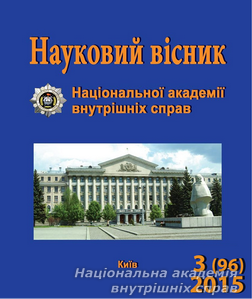Notification of suspicion: procedural significance and subject
Keywords:
institute reported suspicion indictment, criminal offenses, criminal prosecution, the preventive measure
Abstract
Article provides complex scientific analysis of criminal procedural institute of suspicion notification including its procedural form, subject and significance in criminal proceeding. Author underlines that the decision of suspect’s notification does not indicate that the aim of pretrial investigation is achieved and it is considered to be completed. It requires additional interrogation of the suspect to be conducted after the notification, check the testimony given and take other necessary procedural actions. It must be noted that verification of suspect’s testimony and other information collected during the pretrial investigation may lead to conclusion that available proof of suspect’s guilt for committal of criminal offence is inconclusive or the suspect’s vindication – in this case the criminal proceeding must be completed according to Article 284 of CPC of Ukraine. Investigator or prosecutor provide their own opinion of the suspect’s guilt in the notification based on the assessment of the evidence contained in the criminal proceeding materials by the time of the relevant decision to be made. But the act itself does not officially claim on behalf of the State the person to be guilty in committal of the criminal offence. Despite the guilt conclusion is official it is still taken as personal (subjective) opinion of investigator/prosecutor concerning criminal responsibility of the suspected person. According to the principle of guilt presumption suspect is considered to be not guilty till the evidence will be presented for the opposite under legal procedure. Institute of suspicion notification has basically replaced the institute of accusation on the pretrial investigation stage. Except for detention any form of preventive measure application must be preceded by the notification of suspicion as the suspect’s status is gained only after the person is officially detained or upon written notice of the suspicion.Downloads
Download data is not yet available.
Abstract views: 49 PDF Downloads: 3806
How to Cite
[1]
Rogatiuk, I. 1. Notification of suspicion: procedural significance and subject. Scientific Herald of the National Academy of Internal Affairs. 96, 3 (1), 115-124.
Issue
Section
Theoretical and practical aspects of legal science
- Authors reserve the right to authorship of their own work and transfer to the magazine the right of the first publication of this work under the terms of the Creative Commons Attribution License, which allows other persons to freely distribute published work with mandatory reference to authors of the original work and the first publication of an article in this magazine.
- Authors have the right to enter into separate additional agreements on non-exclusive dissemination of the work in the form in which it was published in the journal (for example, to post an article in the institution's repository or to publish as part of a monograph), provided that the link to the first publication of the work in this journal is maintained.
- The journal's policy allows and encourages the posting of articles by authors on the Internet (for example, in electronic storehouses of institutions or on personal websites), both before the submission of this manuscript to the editorial office and during its editorial processing, as this contributes to the creation of a productive scientific discussion and positively affects the efficiency and dynamics of citing the published work.




